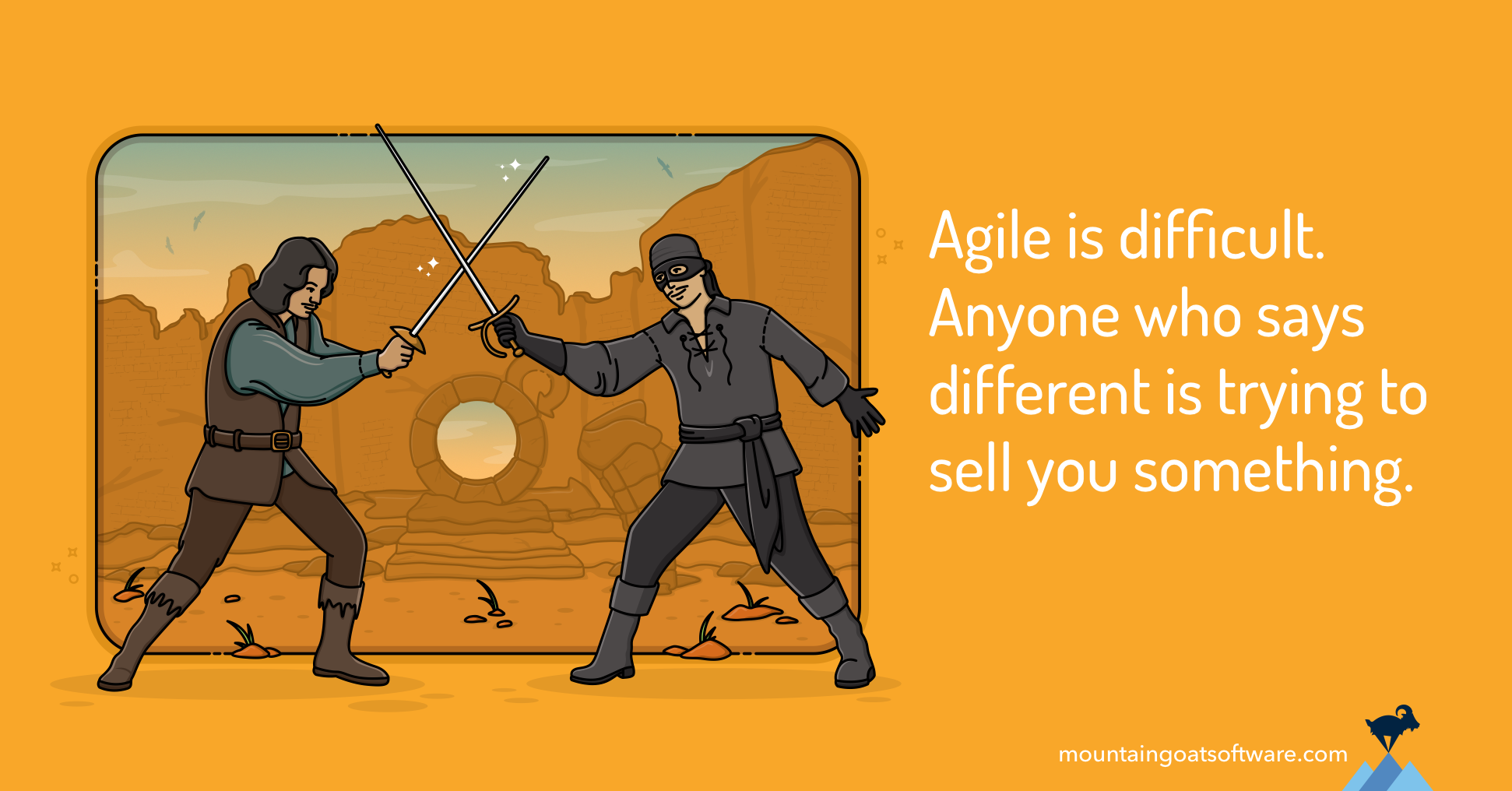Have you seen the movie The Princess Bride? If not, that’s "inconceivable" (to quote the beloved character Vizzini)!
On the surface, the movie is a swashbuckling tale of high adventure, pirates, torture, and true love. But when I watch it, I see that the movie is actually full of advice for agile team members. The book is even better!
Here are nine takeaways for agile teams from The Princess Bride. (As with The Princess Bride, you have two options for enjoying these takeaways. You can read the article or watch the video!)
1. Agile Teams Don't Rush
In the movie, the hero Westley dies but turns out to be only “mostly dead.” This is good news because a miracle can bring him back to life. For various reasons, Westley's compatriots want that miracle to happen fast! Miracle Max brushes aside that urgency by saying, “You rush a miracle man, you get rotten miracles.”
Max’s words remind agile teams: Be Quick, But Don't Hurry
When an agile team hurries, it creates quality problems they’ll need to solve later. No rushing for miracle men or for agile teams.
2. Iterating Gets Easier Over Time
As the hero of the story, Westley faces many trials. In one, Westley must drink wine laced with poisonous iocane powder. Normally this would be fatal, but he has spent years building up a tolerance to iocane. He drinks it and survives.
Few agile teams need to become accustomed to drinking iocane powder. However, all high-performing agile teams do need to become accustomed to practices that might feel awkward or unfamiliar.
By adopting agile practices in small doses, agile teams can learn new ways of working without becoming overwhelmed. That holds true whether the practice is iterating, test automation, overlapping work, or writing user stories.
Like iocane powder, agile practices do get easier to take over time.
3. The Scrum Master Is a Role
One character, the Dread Pirate Roberts, turns out to be a role filled by a progression of pirates who all assume the same name.
When the first Dread Pirate Roberts retired, his second-in-command carried on under the same name. (He decided that would be easier than building his own reputation as the Dread Pirate Clooney.) When he retired, a third Dread Pirate Roberts took over, and so on.
In other words, the Dread Pirate Roberts was a defined role that was filled by one pirate at a time.
It’s the same for Scrum Masters. Scrum teams should have one Scrum Master at a time.
4. Agile Teams Can and Do Use Tools
The Agile Manifesto is well known for favoring, “individuals and interactions over process and tools.” This doesn’t mean agile teams are opposed to tools. Successful agile teams choose tools that support individuals and interactions.
A good tool—such as the holocaust cloak used by Fezzik in the movie—can really be a lifesaver for a team.
5. Things Are Rarely as Scary as They Seem
Going through a change can seem frightening. Introducing an agile way of working, for example, can be scary for team members. They likely have many questions, including these, swirling through their minds:
- How does design fit into agile project management frameworks like Scrum?
- How can we collaborate to finish testing in the same iteration as coding?
- How does a cross-functional team work?
- How do we turn a cross-functional group into a high-performing agile team?
- What do product owners do?
- How do we involve customer and stakeholders while we're developing the product?
In the movie, Westley and Buttercup must navigate the Fire Swamps and battle the Rodents of Unusual Size (ROUS) that live there. Buttercup in particular is fearful because, as Westley acknowledges, no one has ever survived the Fire Swamps
But once through the Fire Swamps, Westley concludes, “It’s not that bad! Well, I’m not saying I’d like to build a summer home here, but the trees are actually quite lovely.”
Agile teams need the courage to handle the stressful situations that might arise as they attempt new ways of working. They’ll rarely find anything as intimidating as fire swamps or ROUSs.
6. Agile Teams Work at a Sustainable Pace
In The Princess Bride, Count Rugen offers the advice, “Get some rest. If you haven’t got your health then you haven’t got anything.“
Agile teams practice this through the principle of sustainable pace. Working at a steady, consistent pace beats frantic overtime followed by periods of recovery.
7. Agile Teams Settle Arguments through Action
In a classic scene from The Princess Bride, Vizzini (a genius who makes Plato, Aristotle, and Socrates look like morons) argues with The Man in Black.
Not Johnny Cash–a different man in black. This was before Johnny Cash. But after arguing. Everything came after arguing.
No matter how well Vizzini reasons through his predicament, he and The Man in Black only resolve it through action. It’s the same with agile teams. Team members can debate process changes or technical decisions endlessly, but the only way to resolve the dispute is to try something and see how it works.
8. Flexibility Is Essential
Teams working in an agile environment benefit from having members with more than one skill. It helps for example, to have a tester who can write some JavaScript or the programmer who can make database changes.
Inigo Montoya demonstrates the ultimate in flexibility by sword fighting with both his left and right hands as needed.
9. Rely on Reason, Not Guesses
In the book, Vizzini, with his staggering intellect, says,“I don’t guess. I think. I ponder. I deduce. Then I decide. But I never guess.”
When identifying changes to make, agile teams should do the same. Think about the sprint that is ending, ponder possible improvements to make, then deduce and decide on the most promising.
Applying Lessons from The Princess Bride
I hope The Princess Bride can help reinforce these agile lessons for you. I know it’s cliché to say so, but the book is much better than the movie. Check it out if you haven’t yet.
Remember, agile is difficult. Anyone who says different is trying to sell you something.
Now, anybody want a peanut?
Last update: June 26th, 2024









